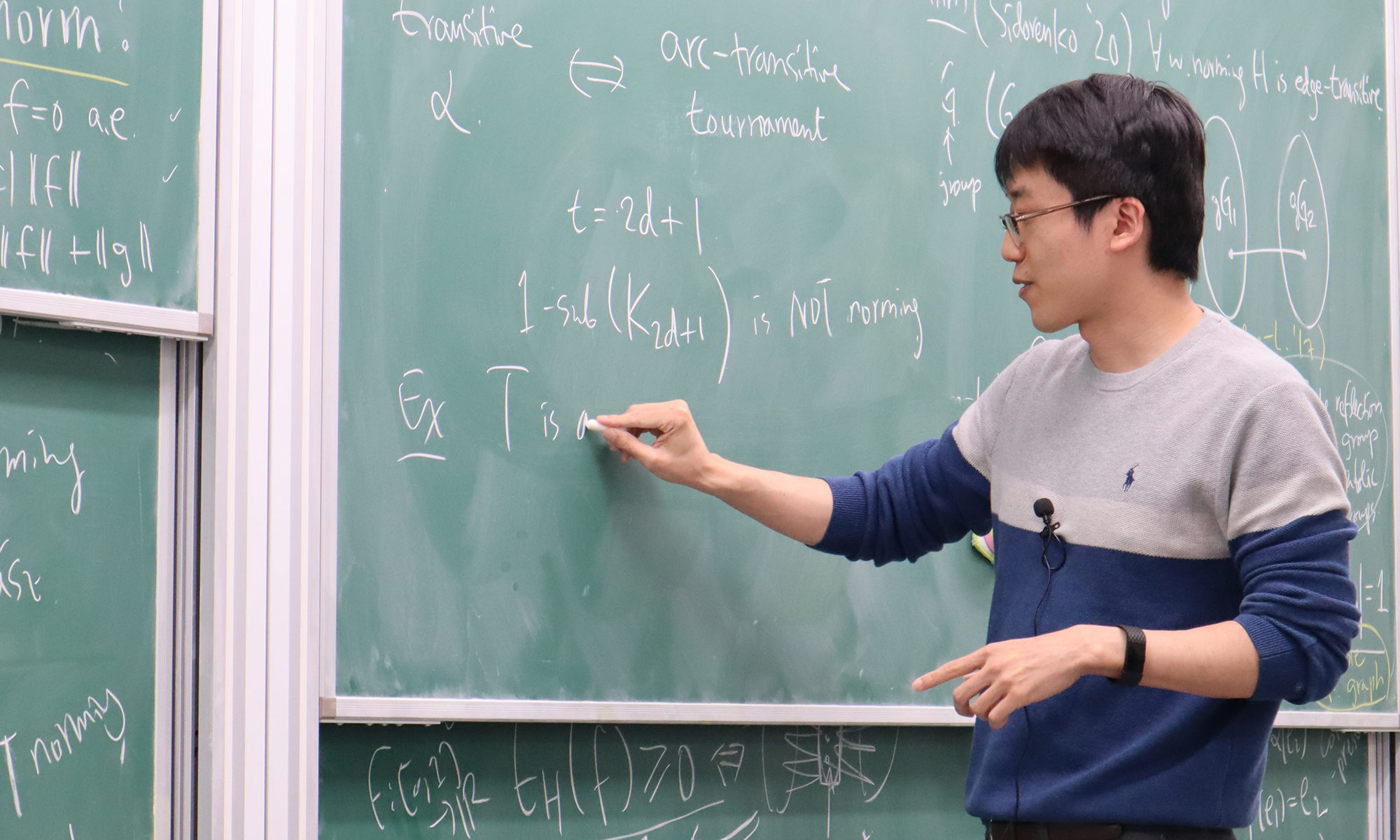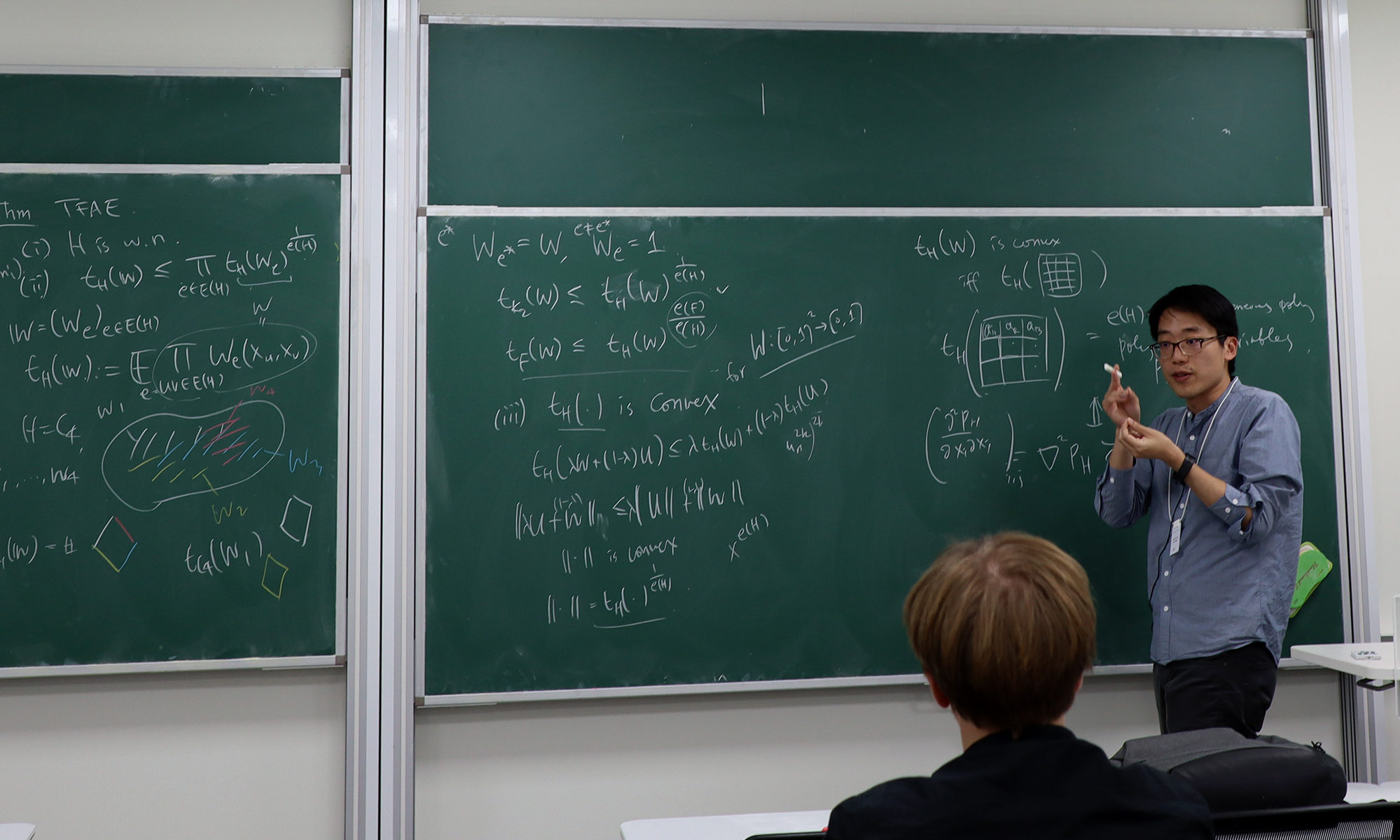The 2021 Combinatorics Workshop (2021 조합론 학술대회) was held from December 20, 2021 to December 22, 2021 at the Bloomvista, Yangpyeong. There were 5 invited talks and 12 contributed talks.
Invited Speakers
- Dongsu Kim, KAIST
- Joonkyung Lee, Hanyang University
- Hong Liu, University of Warwick, UK
- Suil O, SUNY Korea
- Seonjeong Park, Jeonju University
Speakers of the contributed talks
- Jungho Ahn, KAIST / IBS DIMAG
- Jin-Hwan Cho, NIMS
- Linda Cook, IBS DIMAG
- Cheolwon Heo, Sungkyunkwan University
- Seonghyuk Im, KAIST
- Hyobin Kim, Kyungpook National University
- Minki Kim, IBS DIMAG
- Hyemin Kwon, Ajou University
- Hyunwoo Lee, KAIST
- Sang June Lee, Kyung Hee University
- Jaehyeon Seo, KAIST
- Semin Yoo, KIAS
Organizing Committee
- Jeong-Ok Choi, GIST
- Sang-il Oum, IBS DIMAG / KAIST
- Heesung Shin, Inha University
Participants (50 people, all of whom are fully vaccinated against COVID-19)
- Jungho Ahn, speaker, KAIST / IBS DIMAG
- Sejeong Bang, session chair, Yeungnam University
- Rutger Campbell, IBS DIMAG
- Debsoumya Chakraborti, IBS DIMAG
- Eun-Kyung Cho, Hankuk University of Foreign Studies
- Hyunsoo Cho, Ewha Womans University
- Jin-Hwan Cho, speaker, NIMS
- Jeong-Ok Choi, organizer/session chair, GIST
- Linda Cook, speaker, IBS DIMAG
- Taehyun Eom, KAIST
- Cheolwon Heo, speaker, Sungkyunkwan University
- Seonghyuk Im, speaker, KAIST
- Jihyeug Jang, Sungkyunkwan University
- Dosang Joe, NIMS
- Donggyu Kim, KAIST / IBS DIMAG
- Donghyun Kim, Sungkyunkwan University
- Dongsu Kim, invited speaker, KAIST
- Hyobin Kim, speaker, Kyungpook National University
- Jaehoon Kim, KAIST
- Jang Soo Kim, Sungkyunkwan University
- Jinha Kim, IBS DIMAG
- Minki Kim, speaker, IBS DIMAG
- Seog-Jin Kim, session chair, Konkuk University
- Doowon Koh, Chungbuk National University
- Hyemin Kwon, speaker, Ajou University
- O-joung Kwon, Incheon National University / IBS DIMAG
- Dabeen Lee, IBS DIMAG
- Duksang Lee, KAIST / IBS DIMAG
- Hyunwoo Lee, speaker, KAIST
- Joonkyung Lee, invited speaker, Hanyang University
- Sang June Lee, speaker, Kyung Hee University
- Seung Jin Lee, Seoul National University
- Hong Liu, invited speaker, University of Warwick, UK
- Ben Lund, IBS DIMAG
- Suil O, invited speaker, SUNY Korea
- Jaeseong Oh, KIAS
- Sang-il Oum, organizer/session chair, IBS DIMAG / KAIST
- Jae Hyun Park, Kyung Hee University
- Seonjeong Park, invited speaker, Jeonju University
- Jaehyeon Seo, speaker, KAIST
- Seunghyun Seo, session chair, Kangwon National University
- Heesung Shin, organizer/session chair, Inha University
- Mark Siggers, Kyungpook National University
- Jaebum Sohn, Yonsei University
- Minho Song, Sungkyunkwan University
- U-keun Song, Sungkyunkwan University
- Jeong Hyun Sung, Seoul National University
- Tuan Tran, IBS DIMAG
- Sounggun Wee, KAIST / IBS DIMAG
- Semin Yoo, speaker, KIAS





